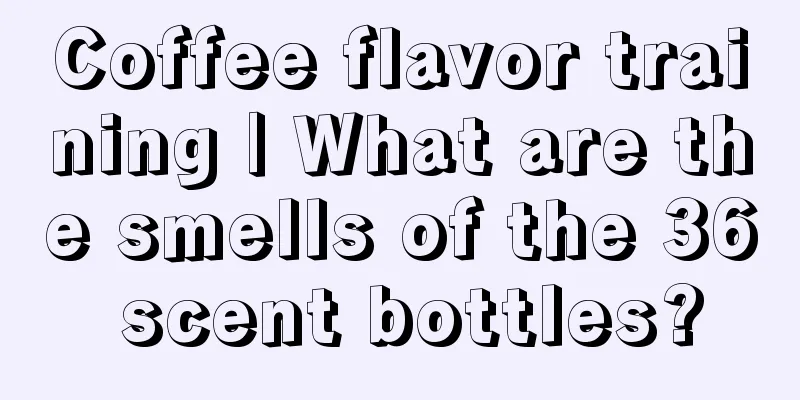
The concept of scent bottles is transferred from wine tasting. It is a systematic classification of aromas to present different smells with blended chemical oils. Its ancestor is said to have collected various materials, directly taking certain plants and foods and putting them into glass bottles for storage. When training, the bottles would be opened to smell the aroma. Fresh materials that have not undergone special preservation treatment will spoil and stink very quickly, so there are now chemical oil scent bottles that can be preserved for more than 5 years.
The coffee noses are divided into four groups, with 9 noses in each group.
1. Enzyme reaction:
2. Potatoes - Fragrance Group: Earth, Sulfur
3. Peas - Aroma Group: Vegetables
4. Cucumber - Aroma Group: Vegetables
11. Tea Rose/Red Currant Jam——Fragrance Group: Flowers/Fruits
12. Coffee flower - Fragrance group: Flowers and plants
15. Lemon - Fragrance Group: Citrus
16. Apricot Fruit——Fragrance Group: Fruit
17. Apple - Fragrance Group: Fruit
19. Honey - Fragrance group: floral, waxy
2. Caramelization reaction:
10. Vanilla - Fragrance Group: Balsamic, Sweet
18. Fresh Cream - Fragrance Group: Cream
22. Toast - Aroma Group: Toasted
25. Caramel - Fragrance Group: Baked
26. Dark Chocolate - Fragrance Group: Baked
27. Almonds (roasted) - Aroma Group: Roasted (dried fruit)
28. Peanuts (roasted) - Aroma Group: Roasted
29. Hazelnut (roasted) - Aroma Group: Roasted (dried fruit)
30. Walnut - Aroma Group: Roasted (dried fruit)
3. Dry distillation reaction:
6. Cedar – Fragrance Group: Trees
7. Cloves - Fragrance Group: Spicy-Sweet
8. Pepper - Aroma Group: Strong, Pepper (a chemical in plants)
9. Coriander seeds - Fragrance group: Flowers and herbs - spicy
14. Black currant - aroma group: fruity, sulfur
23. Malt - aroma group: roasted flavor, fiber
24. Maple Syrup – Fragrance Group: Wood, Spice
33. Tobacco - Aroma Group: Barbecue
34. Roasted coffee beans - aroma group: roasted flavor, sulfur flavor
4. Flavor defects:
1. Soil - Fragrance Group: Soil
5. Straw - Aroma Group: Vegetables, Dry
13. Coffee pulp - aroma group: fermentation, wine
20. Leather - Fragrance Group: Animal
21. Basmati – Fragrance Group: Cereals
31. Cooked beef - aroma group: roasted, animal
32. Smoke - Aroma Group: Barbecue
35.Medicinal smell——Fragrance group: Chemical substances
36. Rubber - Fragrance Group: Chemicals
So, how do you exercise your sensory abilities?
There are 4W principles for the training of smell:
The first step is to identify what the aroma is: I smell the aroma of grapes and soil;
Step 2: Confirm the concentration: strong grape aroma and light earthy aroma;
The third step is to determine where the perception occurs: the front area of the nose is more obvious, or the aroma is perceived behind the nose during or after swallowing;
Step 4: Confirm when the taste occurs: the top note is grape aroma, and the base note has a bit of earthy smell.
Scent bottles are a good way to exercise your sense of smell and challenge your own sense of smell! But in fact, scent bottles can only give you a rough reference range of smell and cannot fully represent the correct taste of a flavor.
Disclaimer: Some of the pictures in this article are from the Internet. For some of the content on the website, such as pictures, we will respect the copyright of the original work and indicate the source, but due to the large number of pictures, some pictures and texts may not be indicated in time, please forgive me. If the original author has any disputes, please contact the website to deal with it. Once verified, we will correct it immediately. It is edited by "Coffee Workshop". Please indicate the source when reprinting. This article is intended to spread coffee culture. If there is any infringement, please inform us to delete it. Thank you~!
